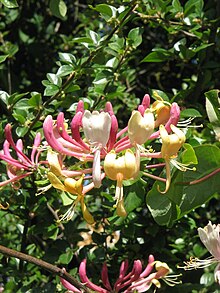| Honeysuckle Temporal range:
| |
|---|---|

| |

| |
| 1. A flowering branch, 2. A fruiting branch, 3. Longitudinal section of a flower, 4. Fruit cut horizontally. | |
| Scientific classification | |
| Kingdom: | Plantae |
| Clade: | Tracheophytes |
| Clade: | Angiosperms |
| Clade: | Eudicots |
| Clade: | Asterids |
| Order: | Dipsacales |
| Family: | Caprifoliaceae |
| Subfamily: | Caprifolioideae |
| Genus: | Lonicera L. (1753) |
| Type species | |
| Lonicera caprifolium L.
| |
| Species[1] | |
|
158; see text | |
| Synonyms[1] | |
| |
Honeysuckles are arching shrubs or twining vines in the genus Lonicera (/lɒˈnɪsərə/[2]) of the family Caprifoliaceae. It includes 158 species[1] native to northern latitudes in North America, Eurasia, and North Africa.[1][3] Widely known species include Lonicera periclymenum (common honeysuckle or woodbine), Lonicera japonica (Japanese honeysuckle, white honeysuckle, or Chinese honeysuckle) and Lonicera sempervirens (coral honeysuckle, trumpet honeysuckle, or woodbine honeysuckle). L. japonica is a highly invasive species considered a significant pest in parts of North America, Europe, South America, Australia, and Africa.[3]
Some species are highly fragrant and colorful, so are cultivated as ornamental garden plants. In North America, hummingbirds are attracted to the flowers, especially L. sempervirens and L. ciliosa (orange honeysuckle). Honeysuckle derives its name from the edible sweet nectar obtainable from its tubular flowers.[4] The name Lonicera stems from Adam Lonicer, a Renaissance botanist.[3]
- ^ a b c d "Lonicera L." Plants of the World Online. Board of Trustees of the Royal Botanic Gardens, Kew. 2022. Retrieved 28 April 2024.
- ^ Sunset Western Garden Book, 1995:606–607
- ^ a b c "Lonicera japonica". CABI. 29 November 2018. Retrieved 3 August 2019.
- ^ "Honeysuckle". Merriam-Webster Dictionary. 2017.